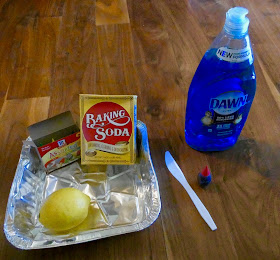Rainbow Column
This experiment takes advantage of density to create a rainbow in a glass. When you add sugar to a liquid, it causes the solution to become denser
Make four different solutions with different densities of sugar. Add a different color to each glass. The colors will layer on top of each other — the denser, more sugary solutions will sit on the bottom and the lightest will sit on the top.
Making Flubber
When you mix glue, water, and a little bit of food coloring, then add some borax, flubber forms. That's because the glue has something called polyvinyl acetate in it, which is a liquid polymer. The borax links the polyvinyl acetate molecules to each other, creating one large, flexible polymer: flubber. More details here Recipe for Flubber
Colorful Milk Experiment
Use milk with higher fat content for a better reaction. In a saucer of milk, drop three or four drops of food coloring. Dip cotton swab in dish soap (I think dawn works the best!)
The detergent lowers the surface tension of the liquid so that the food coloring is free to flow throughout the milk. The detergent reacts with the protein in the milk, altering the shape of those molecules and setting them in motion. The detergent repels the fat (which is why it helps cut grease on dishes). See more details here: Milk and Food Coloring
Make Lava Lamp
Fill a bottle 3/4 full with vegetable oil. Fill the rest with water. Add three or four drops of food coloring.
Break up Alka-Seltzer Tablets into smaller pieces. Add a few to the bottle. Give students a flashlight to shine on the bottle. Water is denser than oil. That is why the oil is on the top. Another concept that you can teach through this exciting activity is polarity (why oil and water do not mix). See more details here Lava Lamp
Lemon Volcano
It is fun to make a lemon volcano and teach about chemical reactions.
You will need these materials: lemons, food coloring, plastic knife, baking soda, dawn dish soap, and a pan or plate.
You will need these materials: lemons, food coloring, plastic knife, baking soda, dawn dish soap, and a pan or plate.
First, add a few drops of food coloring, then dish soap, then baking soda on top. Poke holes in the lemon with the plastic knife. This will help the base and acid mix which will give you a colorful reaction.
I hope you try some of these fun science activities at home!
Thank you for visiting.
Save in my store this week!
Lynda's Store
Dear Teachers, During these extraordinary times of distance teaching, I am allowing you to share my resources or portions of them with the parents of your class. I only ask that when we return to face to face instruction, you go back to abiding by the original terms of use. #distancelearning #teaching #schoolclosure
Dear Teachers, During these extraordinary times of distance teaching, I am allowing you to share my resources or portions of them with the parents of your class. I only ask that when we return to face to face instruction, you go back to abiding by the original terms of use. #distancelearning #teaching #schoolclosure





